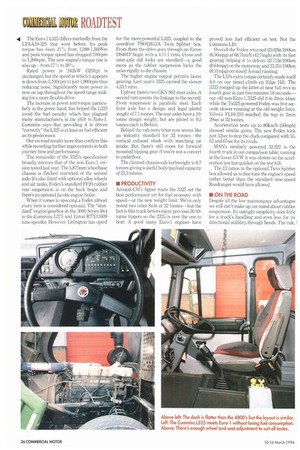ROADTEST
Page 28

If you've noticed an error in this article please click here to report it so we can fix it.
The Euro-1 L325 differs markedly from the LTAA10-325 that went before. Its peak torque has risen 21% from 1,288-1,560Nm and peak torque speed has dropped 100rpm to 1200rpm. The new engine's torque rise is also up—from 17% to 28%.
Rated power at 242kW (325hp) is unchanged, but the speed at which it appears is down from 2,100rpm to just 1,900rpm thus reducing noise. Significantly more power is now on tap throughout the speed range making for a more flexible drive.
The increase in power and torque, particularly in the green band, has helped the L325 avoid the fuel penalty which has plagued many manufacturers in the shift to Eum-1. Cummins says that providing it is driven "correctly" the L325 is at least as fuel efficient as its predecessor.
Our on-road results more than confirm this while recording further improvements in both journey time and performance.
The remainder of the 3325's specification broadly mirrors that of the non Euro-1 version tested last year. The 5,875mm wheelbase chassis is ilitched rearward of the second axle. It's also fitted with optional alloy wheels and air tanks. Foden's standard FF20 rubber rear suspension is on the back bogie and there's an optional Jacobs engine brake.
When it comes to speccing a Foden almost every item is considered optional. The "standard" engine/gearbox in the 3000 Series 8x4 is the Cummins L275 and Eaton RTX11609 nine-speeder, However. Lidington has opted for the more-powerful L325, coupled to the overdrive TS012612A Twin Splitter box. From there the drive goes through an Eaton DS401P bogie with a 4.11:1 ratio. Cross and inter-axle cliff locks are standard—a good move as the rubber suspension locks the axles rigidly to the chassis.
The higher engine output permits faster gearing. Last year's 3325 carried the slower 4.33:1 ratio.
Upfront there's two GKN S63 steer axles. A second ram assists the linkage to the second. Front suspension is parabolic steel. Each front axle has a design and legal plated weight of 7.1 tonnes, The rear axles have a 10tonne design weight, but are plated to 95 tonnes each in Britain.
Behind the cab rests what now seems like an industry standard for 32 tonnes—the vertical exhaust stack with matching air intake. But there's still room for forward mounted tipping gear if you're not a convert to underfloor.
The claimed chassis-cab kerbweight is 8.7 tonnes giving a useful body/payload capacity of 23.3 tonnes.
• PRODUCTIVITY Around CM's tipper route the 3325 set the best performance yet for fuel economy with speed—at the new weight limit. We've only tested two other 8x4s at 32 tonnes—but the fact is this truck betters many previous 30.49tonne tippers so the 3325 is now the one to beat. A good many Euro-1 engines have
proved less fuel efficient on test. Not the Cummins L10.
Overall the Foden returned 33,021ft/100km (8.56mpg) at 68.7km/h (42.7mph) with its fast gearing helping it to deliver 32.711k/100km (8.64mpg) on the motorway and 33.21it./1001on (8.51mpg) on mixed A-road running.
The L10's extra torque certainly made itself felt on our timed climb up Edge Hill. The 3325 romped up the latter at near full revs in fourth gear in just two minutes 18 seconds— our old non-Euro-1 3315 did it in 2min 44sec while the Tx325-powered Foden was five seconds slower running at the old weight limit. Volvo's FL10-310 reached the top in 2min 29sec at 32 tonnes.
Acceleration tests up to 80knVh (50rnph) showed similar gains. The new Foden took just 52sec to stop the clock compared with 55. 62 and 67sec for its rivals.
MAN's similarly powered 32.322 is the fourth truck in our comparison table; running at the lower GVW it was slower on the acceleration test but quicker on the test hill.
The 12 ratios in the optional Twin Splitter box allowed us to fine-tune the engine's speed rather better than the standard nine-speed Roadranger would have allowed.
• ON THE ROAD Despite all the low maintenance advantages we still can't make up our mind about rubber suspension. Its outright simplicity does little for a truck's handling and even less for its directional stability through bends. The ride,




















































































